Name El Umar | Role Political leader | |
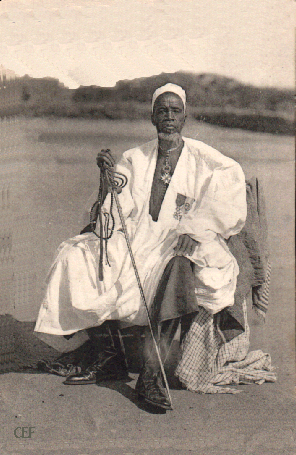 | ||
Born c. 1796 Halvar, Mali Died 10 February 1865 (aged 68–69) Bandiagara Escarpment Religion Islam Parents Sokhna Adama Thiam, Saidou Tall Nationality Senegalese | ||
al-Hajj Umar ibn Sa'id al-Futi Tal (Arabic: حاج عمر بن سعيد طعل), (c. 1794–1864 ), Umar Saidou Tall, born in Futa Tooro, Senegambia, was a West African political leader, Islamic scholar, Tijani Sufi and Toucouleur military commander who founded a brief empire encompassing much of what is now Guinea, Senegal, and Mali.
Contents
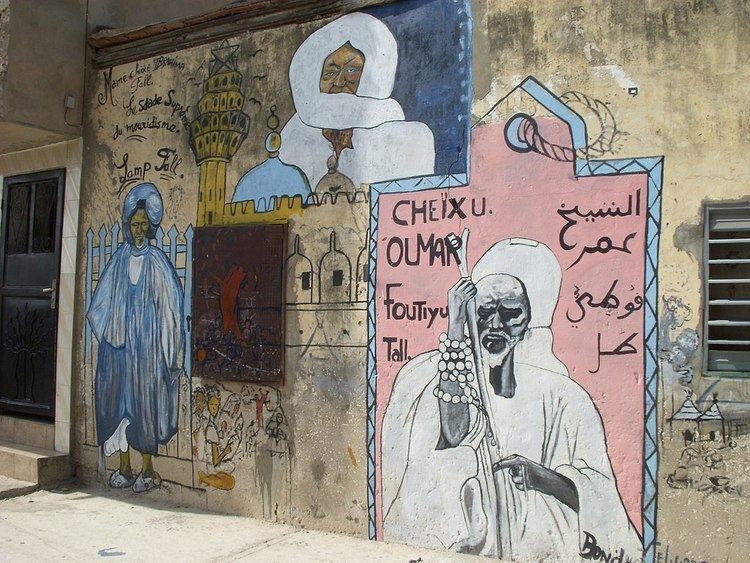
Name
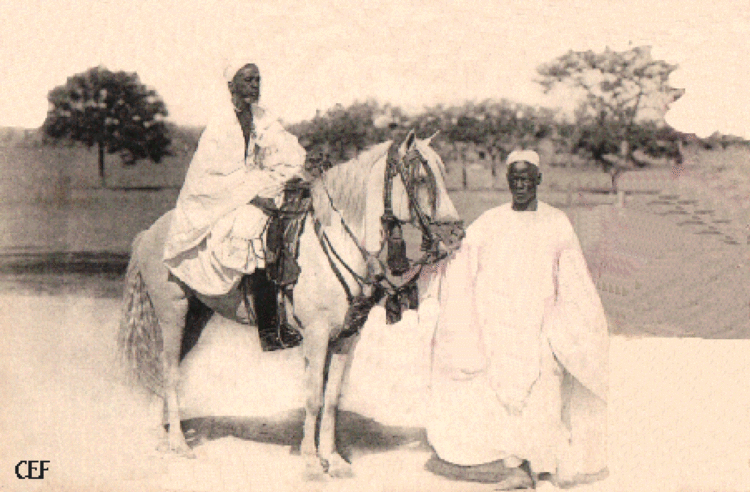
Umar Tall's name is spelled variously: in particular, his first name is commonly transliterated in French as Omar; the patronymic, ibn Sa'id, is often omitted; and the final element of his name, Tall (Arabic: طعل), is spelt variously as Taal or Tal.
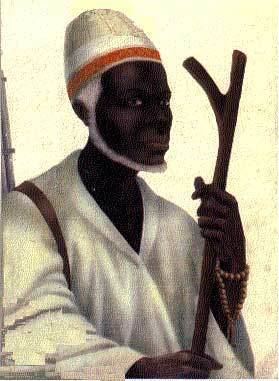
The honorific El Hadj (also al-Hajj or el-Hadj), reserved for a Muslim who has successfully made the Hajj to Mecca, almost always precedes Umar Tall's name. He also later took the honorifics Amir al-Mu'minin, Khalifa, Qutb (pole of the universe), vizier of the Mahdi, Khalifat Khatim al-Awliya (successor of the seal of saints), and Almami (Imam).
Early life

Umar bin Sa'id was born approximately in 1794 in Halwar in the Imamate of Futa Toro (present-day Senegal), Umar was the 10th of 12 children. His father was Saidou Tall, from the torodbe tribe, and his mother was Sokhna Adama Thiam. Umar Tall attended a madrassa before embarking on the Hajj in 1828, returning in 1830 as a marabout with the title El Hadj and was initianted into the Tijaniyya, and then assumed the khalifa of the Tijaniyya sufi brotherhood in the Sudan. El-Hadj took the Tijani honorific Khalifat Khatim al-Awliya. This authority would become the basis of his personal authority necessary to lead Africans.

When returning from the Hajj he camped near Damascus there he met Ibrahim Pasha, Umar Tal befriended the Pasha healed his son from a deadly fever, Umar Tal was highly inspired by the trends set by the Pasha. Settling in Sokoto from 1831-1837, he took several wives, one of whom was a daughter of the Fula Caliph of the Sokoto Caliphate, Muhammed Bello son of Uthman Dan Fodio. In 1836, El Hajj Umar Tall moved to the Imamate of Futa Jallon and then to Dinguiraye in 1840, in present-day Guinea, where he began preparations for his jihad. There he organized his followers into a professional army equipped with French weapons. In 1852 he proclaimed a jihad against pagans, lapsed Muslims, European intruders, and the backsliding rulers of Futa Toro and Futa Jallon.
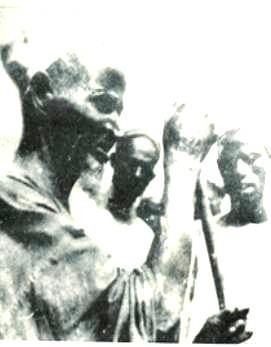
El-Hajj Umar claimed a transcendental personal authority. He denied the important of adherence to a Madhhab and favoured Ijtihad or personal religious judgment. He taught that a believer should follow the guidance of a Sufi Shaykh who has immediate personal knowledge of the divine truth. Even though Umar never took the title of either Mujaddid or Mahdi, he was regarded as such by his followers. He became the torodbe ideal of religious revival and conquest of pagans.
Initial conquests
Umar appealed to the populace of Futa Toro on the basis of local grievances against the military elites. His community also appealed to rootless individuals of mixed ethnic background who found new social identity and opportunities for conquest under the aegis of Islam. His Jihad begain with the conquest of Futa Toro and by 1862 his empire included Timbuktu, Masina, Hamdallahi, and Segu.
In 1848, El Hajj Umar Tall's Toucouleur army, equipped with French weapons, invaded several neighboring, pagan, Malinké regions and met with immediate success. Umar Tall pressed on into what is today the region of Kayes in Mali, conquering a number of cities and building a tata (fortification) near the city of Kayes that is today a popular tourist destination.
In April 1857, Umar Tall declared war on the Khasso kingdom. He came into conflict with the French who were attempting to establish their commercial supremacy along the Senegal river. Umar besieged the French colonial army at Medina Fort. The siege failed on July 18 of the same year when Louis Faidherbe, French governor of Senegal, arrived with relief forces. In 1860 Umar made a treaty with the French that recognized Umar and his followers sphere of influence in Futa Toro and assigned them the Bambara states of Kaarta and Segu.
Conqueror of the Bambara
After his failure to defeat the French, El Hadj Umar Tall launched a series of assaults on the Bambara kingdoms of Kaarta and Segu. The Kaarta capital of Nioro du Sahel fell quickly to Umar Tall's mujahideen, followed by Ségou on March 10, 1861.
While Umar Tall's wars thus far had been against the animist Bambara or the Christian French, he now turned his attention to the smaller Islamic states of the region. Installing his son Ahmadu Tall as imam of Segu, Umar Tall marched down the Niger, on the Massina imamate of Hamdullahi. More than 70,000 died in the three battles that followed until the final fall and destruction of Hamdullahi on March 16, 1862.
Death and legacy
In quest of new territory, Umar and his followers invaded Masina. His enemies were lead by Ahmad al-Bakkai al-Kunti of the Qadari Sufi order. Ahmad denounced this as an illegitimate war of Muslims on Muslims and promoted a coalition of local states, including Masina and Timbuktu, to resist. Now controlling the entire Middle Niger, Umar Tall moved against Timbuktu, only to be repulsed in 1863 by combined forces of Tuaregs, Moors, and Fulas. Meanwhile, a rebellion broke out in Hamdullahi under Ba Lobbo, cousin of executed Massina monarch Amadu III; in 1864, Balobo's combined force of Fulas and Kountas drove Umar Tall's army from the city and into Bandiagara, where Umar Tall died in an explosion of his gunpowder reserves on February 12. His followers captured Hamdallahi and established a state that lasted until 1893. His nephew Tidiani Tall succeeded him as the Toucouleur emperor, though his son Ahmadu Tall did much of the work to keep the empire intact from Ségou. However, the French continued to advance, finally entering Ségou itself in 1890. The Jihad state was simply absorbed into the growing French West African empire.
El Hadj Umar Tall remains a prominent figure in Senegal, Guinea, and Mali, though his legacy varies by country. Where many Senegalese tend to remember him as a hero of anti-French resistance, Malian sources tend to describe him as an invader who prepared the way for the French by weakening West Africa. Umar Tall also figures prominently in Maryse Condé's historical novel Segu. He remains to this day an influential figure in the Tijaniyya and other reformist movements, which stressed the importance of Muslim orthopraxy. Umar's state forbade dancing, the use of tobacco, alcohol, charms, pagan ceremonies, and the worship of idols. Many un-Islamic practices were banned. These laws were also very strictly enforce, especially the ban on alcohol. Umar abolished uncanonical taxes and replaced them with zakat, land taxes, and jizya. Polygamists were restricted to only four wives. Umar, however, was uninterested in the logistical aspects of inculcating Islam such as building courts, madrassahs, and mosques. The primary function of Umar's state was predatory warfare, slaving, the accumulation of booty, and the reform of morals.
